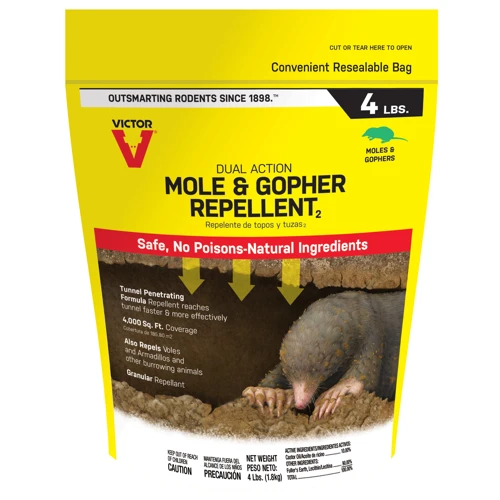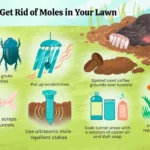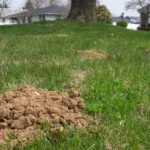It’s a beautiful summer day, but as you step outside, you notice the damage left behind by the resident moles digging up your yard. Moles can cause significant harm to your landscape, leaving unsightly mounds of dirt and damaging plant roots. But what attracts moles, and how can you get rid of them without resorting to harmful chemicals? One effective solution is castor oil-based mole repellents. In this article, we’ll explore the benefits of using castor oil-based mole repellents, how to use them, and additional tips for mole control.
What are Moles?
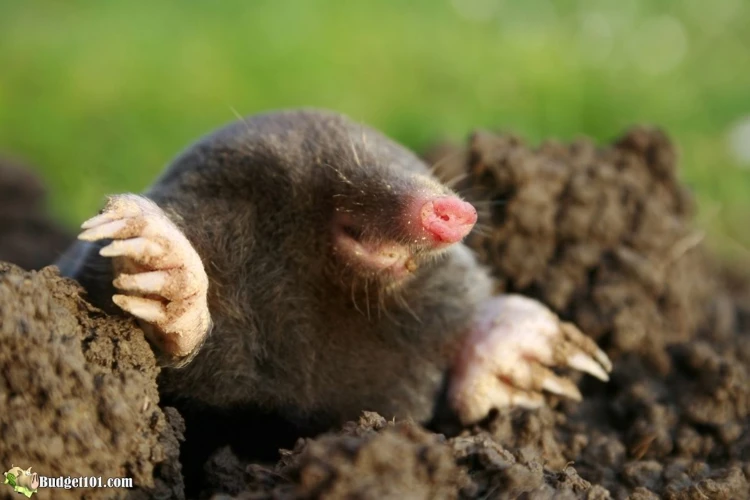
If you have noticed raised ridges and mounds of soil in your yard, you might have a mole infestation. Moles are small, furry mammals that are often mistaken for rodents. However, they are more closely related to shrews and hedgehogs. They have pointed snouts, tiny eyes, and large front paws that are perfectly adapted for digging. Moles are known for tunneling through lawns and gardens, uprooting plants, and creating unsightly bumps in the soil. If you are struggling with a mole problem, keep reading to learn more about these pests and how to deal with them using castor oil-based mole repellents.
Identifying Moles in Your Yard
Identifying Moles in Your Yard
Moles are small burrowing mammals that can create extensive tunnel networks in your yard, causing damage to grass, plants, and trees. It is important to identify the presence of moles in your yard in order to take appropriate measures. Here are some key signs to look for:
| Mole Hills | Moles create mounds of soil as they burrow through your yard. These mounds are typically conical in shape and can range from a few inches to a foot in height. |
| Tunneling | Moles create long tunnels just below the surface of your lawn. These tunnels can be identified by the raised ridges that appear in the grass above. |
| Wilting Plants | If you notice a sudden onset of wilting plants or yellowing grass, it could be due to moles burrowing through the roots and disrupting their access to water and nutrients. |
| Unusual Ground Patterns | If you notice unusual patterns in the ground, such as raised ridges or sunken areas, it could be a sign of moles tunneling below. |
If you suspect the presence of moles in your yard, it is important to take action to prevent damage. Castor oil-based mole repellents can be an effective and eco-friendly solution. For more information on other plant-based mole control solutions, check out our article on 5 Plant-Based Mole Control Solutions.
What Attracts Moles?
Mo!es are often viewed as pests because of the maze-like tunnels and piles of dirt they create in yards and gardens. These small, insectivorous mammals are attracted to moist soil that is rich in organic matter and is ideally suited for earthworms, grubs, and other soil-dwelling insects which make up their main diet. Moles are also drawn to areas with a lot of cover, such as thickets and dense vegetation, as they provide easy camouflage and protection from predators.
The top factors that attract moles to certain areas are:
- Moisture: Moles prefer damp soil with good drainage as they need to stay hydrated.
- Soil type: Moles prefer soft, loamy soil that is easy to dig through.
- Food: Moles feed on earthworms, grubs, and other insects that live in the soil.
- Vegetation: Moles often establish their burrows in areas with dense vegetation as this provides cover and protection from predators.
While moles are not harmful to people, they can cause significant damage to lawns and gardens as they create tunnels and mounds that can make the soil uneven and unsuitable for planting. In the next section, we will explore how castor oil-based mole repellents can be used effectively to deter moles from settling in your yard.
If you would like more information on other natural mole repellents, see our article on plants that are known to be effective mole deterrents. You might also want to learn about how essential oils can be used for mole control or how herbs can be used to prevent moles.
Why Use Castor Oil-Based Mole Repellents?
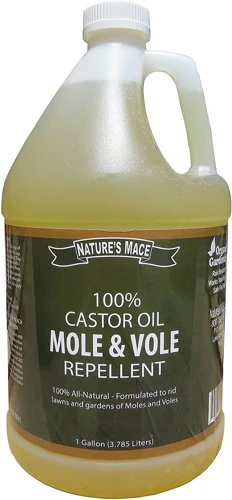
If you’re one of the many homeowners who has struggled with the frustration of yard damage caused by moles, you may be wondering what measures you can take to keep these pests at bay. While there are no shortage of solutions available on the market, castor oil-based mole repellents have emerged as a highly effective and eco-friendly solution to this common problem. Not only is castor oil a natural and safe alternative to harmful chemicals, but it also offers a number of benefits that make it an ideal choice for those seeking a cost-effective and long-lasting solution to their mole problem. In this section, we’ll explore the reasons why castor oil-based mole repellents have become such a popular choice amongst homeowners, and why you might want to consider using them to protect your lawn and garden.
Castor Oil: An Effective Repellent
Castor oil has been used for many years as a natural mole repellent. It contains a compound known as ricinoleic acid which is detested by moles due to its strong smell and taste. This compound also causes mild irritation to the moles’ skin, making it difficult for them to tolerate it.
Additionally, castor oil-based mole repellents are effective because they alter the taste and smell of the soil, making it difficult for moles to find their favorite foods. This discourages them from further foraging and burrowing in lawns and gardens.
Castor oil-based mole repellents offer a long-lasting solution to mole infestations. Unlike chemical solutions, which require frequent applications, castor oil-based products can provide up to two months of coverage before needing a reapplication.
Lastly, it is worth noting that not all castor oil is equally effective. Mole repellents made from expeller-pressed castor oil are the most effective as the oil is extracted without the use of harmful solvents, leaving its natural properties intact. This makes it safe for use around pets, children, and the environment. Castor oil-based mole repellents are a safe, cost-effective, and natural solution for mole control in homes and gardens.
Eco-Friendly Alternative to Chemicals
When it comes to effectively getting rid of moles, there are various methods available, including the use of chemicals. However, these chemicals can be harmful not only to the environment but also to humans and animals. That’s where castor oil-based mole repellents come in as an excellent, eco-friendly alternative to chemicals.
Castor oil is a natural substance derived from castor bean plants. This means that it is biodegradable and can be effectively used as a mole repellent without causing any harm to the environment. In addition to being eco-friendly, these repellents are also safe for your children and pets.
Using castor oil-based mole repellents not only helps control moles but also prevents their entry into your yard in the first place. Unlike chemicals that rely on harsh and harmful ingredients, castor oil-based repellents create an unpleasant environment for moles, making it difficult for them to live or breed in your yard.
Using natural repellents like castor oil-based ones also ensures the prevention of the soil and groundwater from becoming polluted by chemicals. This is because castor oil-based repellents break down into natural components, minimizing their effect on the environment.
Additionally, by using castor oil-based mole repellents, you can enhance the life and growth of your lawn, unlike chemical products that may cause your grass to wither and die. Castor oil-based mole repellents protect your lawn while keeping it looking lush and healthy.
Table:
| Advantages of Castor Oil-based Mole Repellents |
|---|
| Eco-friendly |
| Safe for children and pets |
| Protects soil and water sources from pollution |
| Enhances lawn growth and health |
Safe for Children and Pets
When it comes to getting rid of moles in your yard, it’s important to consider the safety of your family and pets. Castor oil-based mole repellents are a great option for those who want to avoid using harmful chemicals. Here are some reasons why:
- Non-toxic: Castor oil is a natural substance that is safe for humans and animals. It won’t harm your children or pets if they accidentally come into contact with it.
- No harmful chemicals: Unlike chemical-based repellents, castor oil-based mole repellents do not contain harmful pesticides or other toxic chemicals that can be harmful to the environment or your health.
- Harmless to wildlife: Castor oil-based mole repellents are specifically formulated to repel moles and other burrowing animals without causing harm to them. This makes them an eco-friendly option that won’t harm the natural balance of your yard.
- Easy to apply: Castor oil-based mole repellents are typically applied using a simple spray bottle. This easy application method makes it easy to use around your house without worrying about spills or messes.
Castor oil-based mole repellents are a safe and effective way to get rid of moles in your yard without putting your family, pets, or the environment at risk. So, if you want to keep your yard looking beautiful and mole-free, give this natural solution a try!
Cost-Effective Solution
When it comes to controlling moles in your yard, choosing a castor oil-based repellent can be a cost-effective solution compared to other alternatives. Not only is it affordable, but it is also highly effective in keeping moles away from your lawn. Here are some ways in which using castor oil-based mole repellents can save you money:
| Cost Comparison | Castor Oil-Based Repellent | Chemical Repellent | Professional Mole Control Services |
|---|---|---|---|
| Cost per Application | Low | High | Very High |
| Labour Costs | None | None | High |
| Frequency of Application | Infrequent | Regular | Regular |
| Repellent Lifespan | Long | Short | Short |
Chemical repellents often require multiple applications, which can quickly add up in cost. Hiring professional mole control services can be very expensive, with costs that far exceed those of using castor oil-based repellents.
Costs aside, castor oil-based mole repellents are also safer and friendlier to the environment and pets as compared to chemical repellents. They are a natural alternative that effectively repels moles without causing harm to them or the ecosystem.
How to Use Castor Oil-Based Mole Repellents
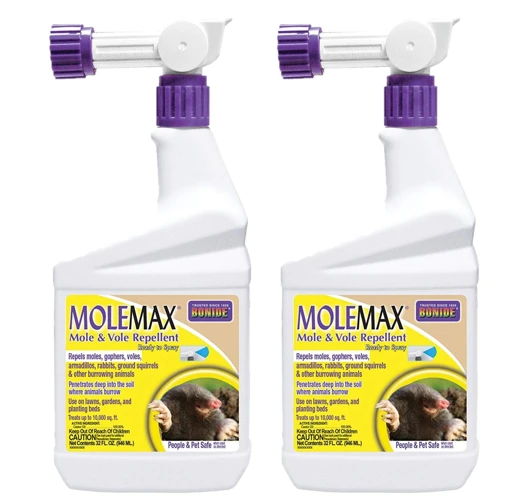
If you’re tired of dealing with pesky moles that seem to be ruining your lawn, it’s time to take matters into your own hands and try out some mole repellents. Castor oil-based mole repellents have proven to be effective in warding off these critters, but figuring out the proper way to use them can be confusing. In this section, we’ll go over the steps you need to follow to properly apply castor oil-based mole repellents and get your yard back to being mole-free.
Choosing the Right Mole Repellent
When it comes to choosing the right mole repellent, there are several factors to consider. Here are some key points to keep in mind:
| Type | Description |
|---|---|
| Granular repellents | Granular repellents are applied to the ground and work by releasing a scent that moles find unpleasant. They typically contain castor oil as the active ingredient, and can be spread with a spreader or by hand. |
| Liquid repellents | Liquid repellents are applied directly to the soil and work by forming a barrier that moles are reluctant to cross. They also typically contain castor oil as the active ingredient, and can be applied via a hose-end sprayer or similar device. |
| Sonic repellents | Sonic or vibration repellents emit a sound or vibration that moles find disturbing. They are typically powered by batteries or solar panels, and are placed in the ground near mole activity. |
One important thing to keep in mind when choosing a mole repellent is that different solutions work better for different situations. For example, if you have a small yard with only a few moles, granular or liquid repellents may be all you need. However, if you have a larger yard with a more serious mole problem, you may need to consider a sonic repellent or even professional extermination services.
It’s also worth noting that not all mole repellents are created equal. Some products may contain harsh chemicals or ingredients that could be harmful to your lawn or the environment. When selecting a repellent, it’s important to look for a product that is safe, effective, and eco-friendly. Many castor oil-based repellents meet these criteria, making them a great choice for mole control.
Applying Castor Oil-Based Repellents
When applying castor oil-based mole repellents, it is important to follow the instructions on the packaging carefully. Here are some general steps to follow:
- Identify active mole tunnels: Before applying the repellent, identify the actively used tunnels by flattening the raised ridges or mounds that are located at the entrance and exit holes of the tunnel.
- Water the area: Water the area you plan to treat thoroughly. This will ensure that the soil is moist and absorbent, allowing the repellent to penetrate effectively.
- Choose the application method: There are several ways to apply castor oil-based repellents, including granules, sprays, or concentrated solutions. Choose the method that best suits your needs and follow the instructions carefully.
- Apply the repellent: Apply the repellent according to the manufacturer’s instructions, making sure to cover the entire area where moles are active.
- Water again: Water the treated area again to help the product penetrate the soil and reach the moles’ tunnels effectively.
It is important to remember that castor oil-based repellents may take a few weeks to become fully effective. Additionally, reapplication may be necessary to maintain effectiveness, especially after heavy rains or watering. By following these steps and using these products regularly, homeowners can effectively control mole infestations and protect their lawns and gardens from damage.
Frequency of Application
It is important to apply castor oil-based mole repellents at the right frequency to ensure maximum effectiveness. The frequency of application can depend on various factors such as weather conditions, soil type, and the severity of the mole infestation. Here are some general guidelines on the frequency of application:
- Initial Application: For best results, apply the repellent when moles are first noticed or at the first sign of damage. This will help establish a barrier and deter moles from further burrowing in the treated area.
- Follow-up Applications: In general, apply the repellent once a month during the active mole season, which typically occurs in the spring and fall. However, if there is heavy rainfall or if there is a high level of mole activity in your yard, you may need to apply it more frequently.
- Reapplication: Remember to reapply the repellent after heavy rain or irrigation, as water can dilute its potency. If you notice new mole activity or signs of damage, reapply the repellent immediately.
- Long-term Maintenance: After several applications and successful mole control, you can reduce the frequency of application to every two to three months or as needed. This will help maintain the barrier and prevent new mole activity from developing.
Following these guidelines can help ensure that your castor oil-based mole repellent is applied at the appropriate frequency, providing long-lasting protection against mole damage in your yard.
Additional Tips for Mole Control
When it comes to controlling moles in your yard, using castor oil-based repellents can be a great solution. However, there are additional measures you can take to ensure your lawn remains mole-free. In this section, we’ll provide some extra tips for effective mole control. By combining these tips with the use of castor oil-based mole repellents, you’ll be able to enjoy a beautiful, mole-free lawn year-round.
Understanding Mole Behavior
To effectively control moles in your yard, it is important to have a basic understanding of their behavior. This will help you choose the right techniques and products to use. Here are some key insights into mole behavior:
| Mole Behavior | Explanation |
|---|---|
| Underground Tunnels | One of the most distinctive characteristics of moles is their ability to tunnel underground. Moles create tunnels in search of food, such as earthworms and insect larvae. These tunnels can be identified by the raised ridges that they create in your lawn. |
| Solitary Creatures | Mothers will only keep their young for a short period and then they are on their own. Moles are notorious for being solitary creatures, which can make them difficult to control. They typically only interact with each other during breeding season which is in the late winter and early spring. |
| Nocturnal Activity | Mothers will babies may be active during the day, but generally moles are most active during the night time. They will stay in their underground burrows during the day and come out only at night to forage for food. |
| Seasonal Patterns | Moles are most active during the spring and fall when the soil is moist and easy to dig. They will tunnel deeper during the summer months and stay closer to the surface during the winter. Their activity is also affected by temperature and rainfall. |
| Mound Building | Moles will often uncover the soil and make small mounds of dirt that are visible on the surface of your lawn. These mounds are created when moles push the soil up from their underground tunnels as they tunnel through the soil in search of food. |
By understanding the behavior of moles, you can determine the best course of action for controlling them in your yard. This may include using castor oil-based mole repellents, as well as maintaining your lawn and eliminating food sources to discourage mole activity.
Proper Lawn Maintenance
Maintaining a healthy lawn is an important step in preventing mole infestations. Here are some tips for proper lawn maintenance to help keep moles away:
- Mow Regularly: Keep your lawn well-groomed by mowing it regularly. Moles prefer to burrow in taller grass, so keeping your lawn trimmed short will discourage them from making their home there.
- Water Appropriately: Water your lawn correctly according to the recommended schedule and amount. Overwatering can create soft, moist soil that moles prefer, so be sure not to overdo it.
- Fertilize Responsibly: While fertilizing is necessary for a healthy lawn, overdoing it can create an excess of earthworms and grubs, which are favorite food sources of moles. Follow recommendations for fertilizing and use organic options when possible.
- Fix Soil Imbalances: Moles are attracted to areas with imbalanced soil, such as those with high acidity or alkalinity levels. Test your soil regularly and adjust the pH if necessary.
- Fill Holes and Tunnels: If you spot any mole holes or tunnels in your lawn, fill them in immediately. This will help discourage moles from using the same spot again and prevent other animals from making their home there.
- Manage Thatch: Thatch, which is the layer of dead grass and roots on top of the soil, can create a habitat that is attractive to moles. Keep thatch levels low by regularly raking your lawn and removing any build-up.
By following these proper lawn maintenance tips, you can help make your lawn less appealing to moles, reducing the likelihood of an infestation. Remember that prevention is key, and taking these steps can help you avoid the need for drastic measures.
Eliminating Food Sources
Moles primarily feed on insects and earthworms. If you want to get rid of moles, it is essential to eliminate their food sources. Here are some ways to do that:
- Reduce Irrigation: Moles prefer moist soil, so if your yard is frequently irrigated, it can attract insects and earthworms, which in turn attract moles. Reduce the amount of watering and let the soil dry out between waterings.
- Remove Yard Debris: Piles of leaves, grass clippings, and other yard debris can attract insects and earthworms. Remove the debris regularly to eliminate these food sources for moles.
- Limit Composting: Composting is a great way to manage yard waste, but it can also attract insects and earthworms. Try to limit the amount of composting you do in your yard, and avoid placing compost piles near your lawn or garden.
- Use Nematodes: Nematodes are microscopic worms that feed on insect larvae. They are an excellent biological control for many insect pests, including grubs, which are a favorite food of moles. Apply nematodes to your lawn in the spring and fall to control the insect population.
By eliminating the food sources for moles, you can decrease the likelihood that they will take up residence in your yard. But keep in mind that even a well-maintained lawn can still attract moles, so it is important to use other mole control measures in conjunction with eliminating their food sources.
Conclusion
In conclusion, using castor oil-based mole repellents is an effective and eco-friendly solution for controlling mole infestations in your yard. Castor oil not only repels moles, but it’s also safe for children and pets, making it a great alternative to chemical-based repellents.
By understanding mole behavior and properly maintaining your lawn, you can also prevent future mole infestations. Eliminating the food sources of moles, such as grubs and insects, can also discourage them from digging tunnels in your yard.
When it comes to controlling moles, prevention is key. By using castor oil-based mole repellents and implementing proper lawn maintenance practices, such as aerating and watering your lawn, you can enjoy a pest-free yard without harming the environment or endangering your loved ones.
Overall, if you’re looking for a cost-effective and safe way to keep moles at bay, castor oil-based repellents are a great option to consider. With their proven effectiveness and eco-friendly benefits, you can finally put an end to your mole troubles and enjoy a beautiful, healthy lawn.
Frequently Asked Questions
How does castor oil repel moles?
Castor oil contains a compound called ricinoleic acid, which is known to repel moles by altering the taste and smell of the soil, making it unattractive to them.
Is castor oil-based mole repellent safe for the environment?
Yes, castor oil is a natural and biodegradable substance, making it a safe and eco-friendly alternative to chemical-based repellents.
How does castor oil-based repellent compare to other mole control methods?
Castor oil-based repellents are a more natural and cost-effective solution compared to traditional methods such as traps, poisons, or hiring a pest control service.
Will castor oil-based mole repellent harm pets?
No, castor oil-based repellents are safe for pets and children as they do not contain any harmful chemicals.
Can I make my own castor oil-based mole repellent?
Yes, you can make your own mole repellent at home by mixing castor oil with water and dish soap. However, it may not be as effective as commercially available options.
How soon should I expect to see results from using castor oil-based repellent?
You should start to see results within a few days of applying the repellent, as moles will begin to avoid the treated areas.
How often should I apply castor oil-based mole repellent?
It is recommended to apply the repellent every 2-3 months or after heavy rainfall to ensure continued effectiveness.
Can castor oil-based repellent be used on any type of soil?
Yes, castor oil-based repellents can be used on any type of soil, including sandy or clay soils.
Will castor oil-based mole repellent harm beneficial insects or earthworms?
No, castor oil-based repellents are not harmful to beneficial insects or earthworms as they only affect the taste and smell of the soil for moles.
Are there any precautions I should take when using castor oil-based mole repellent?
It is recommended to wear gloves when applying the repellent, as it can cause skin irritation. Additionally, avoid applying the repellent near any water sources to prevent contamination.

